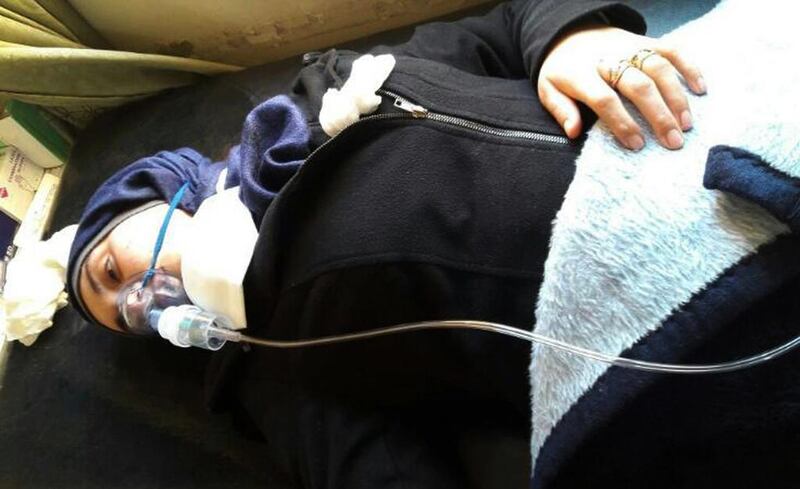Chemical weapons experts and doctors said a nerve agent – possibly sarin – was used in the attack that killed at least 75 people in Khan Sheikhoun, a rebel-held town in the northern Syrian province of Idlib.
The same agent was used to kill more than 1,300 people in Ghouta, outside Damascus, in 2013, in an attack widely blamed on the Assad regime.
Medecins Sans Frontieres said its team had reached victims who were suffering symptoms “consistent with exposure to a neurotoxic agent such as sarin gas”.
Eight of the patients at the Bab Al Hawa hospital north of the attack site had “constricted pupils, muscle spasms and involuntary defecation”, MSF said. Victims in other hospitals had a strong smell of bleach, suggesting that chlorine had also been used.
The World Health Organization (WHO) said reports and images from Khan Sheikhoun strongly indicated the use of chemical weapons. The United Nations body also pointed to the “apparent lack of external injuries reported in cases showing a rapid onset of similar symptoms, including acute respiratory distress as the main cause of death”.
“Some cases appear to show additional signs consistent with exposure to organophosphorus chemicals, a category of chemicals that includes nerve agents,” WHO said.
The dozens who were injured in Tuesday’s attack and admitted to hospitals were “suffering from breathing difficulties and suffocation”– further indications of the use of chemical weapons, WHO said.
One of the drugs WHO is shipping to these hospitals is atropine, which is used to treat attacks by banned nerve agents like sarin.
Sarin is an odourless, colourless agent that interferes with nerve pathways. It blocks a person’s control of involuntary muscles and organs, leading to vomiting, foaming mouths, watering eyes, blurred vision, restricted breathing, and convulsions.
Upon exposure, a person can absorb sarin through the skin, or breathe it in through the lungs. The agent does not always kill, but it inevitably leads to excruciating pain.
A doctor in Idlib also posted photographs online of victims with constricted pupils – a frequent indicator of a sarin attack.
But Brett Edwards, a lecturer in security studies at the University of Bath, cautioned that evidence is, as yet, scanty.
"Even with the pin-dot pupils, for example, the problem is – it's not just sarin that would cause that," he told The National. A nerve agent known as VX, for example, also causes similar effects.
The Syrian regime has used chlorine in past attacks, but the symptoms differ. Chlorine affects the respiratory system, resulting in coughing, shortness of breath and nausea.
“If you’re looking for evidence, you’re going to be looking for delivery systems,” Dr Edwards said. “It would have been delivered from the air, from helicopters or airplanes belonging to Syria or Russia.”
Witnesses say Tuesday’s attack was carried out by either Russian or Syrian Sukhoi jets, according to the Associated Press.
But both Syria and its ally Russia have denied that a chemical attack even occurred. Igor Konashenkov, a spokesperson for the Russian defence ministry, said a Syrian airstrike hit a warehouse being used as a rebel factory that was filled with shells of toxic gas.
Mr Konashenkov also said the weapons in the factory were intended for unnamed militants in Iraq. So far, no evidence has emerged that the Syrian rebels have the ability to run a sophisticated weapons manufacturing programme, however. Meanwhile, rebel-held Idlib is cut off from Iraq, which would make it difficult for weapons to be transported to militants there.
Eliot Higgins, who runs Bellingcat, a research network that investigates conflicts, told The National that the Russian version of events sounded implausible.
“The problem is, the first images of victims of the attack appeared online at around 6.30am GMT – so two to three hours before the warehouse was bombed, so it can’t be responsible for the chemical release,” Mr Higgins said. “Its worth noting we’ve caught the Russian [defence ministry] lying repeatedly about air strikes in Syria, even to the extent of presenting fake evidence, so it would be unsurprising if they lied about this as well.”
Like Dr Edwards, Mr Higgins said “it’s impossible to identify the munitions at this stage”.
On BBC Radio 4’s Today programme, Hamish de Bretton Gordon, a former commanding officer of the UK’s Chemical, Biological, Radiological and Nuclear (CBRN) Regiment, called Russia’s claim “completely untrue”.
“I think this is pretty fanciful. No doubt the Russians are trying to protect their allies,” he said. “Axiomatically, if you blow up sarin, you destroy it.”
Dr Edwards said countries and aid agencies should force an evidence-gathering team into Syria to investigate the Idlib attack and others.
“Four years after the Ghouta attacks, we’re still debating evidence, because it wasn’t properly investigated,” he said. “It would be disgusting if we allow Russia and others to prevent an on-the-ground investigation.”
SSubramanian@thenational.ae





